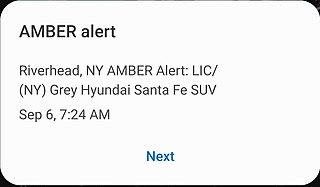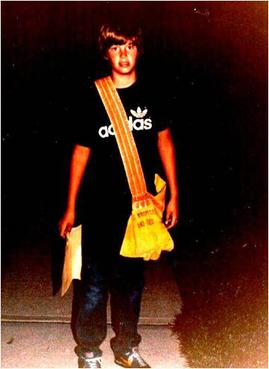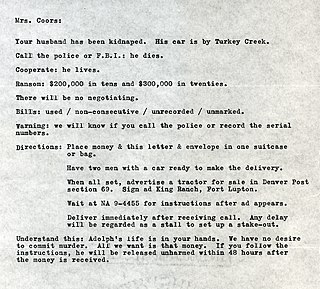
An Amber alert or a child abduction emergency alert is a message distributed by a child abduction alert system to ask the public for help in finding abducted children. The system originated in the United States of America.

A missing person is a person who has disappeared and whose status as alive or dead cannot be confirmed as their location and condition are unknown. A person may go missing through a voluntary disappearance, or else due to an accident, crime, death in a location where they cannot be found, or many other reasons. In most parts of the world, a missing person will usually be found quickly. While criminal abductions are some of the most widely reported missing person cases, these account for only 2–5% of missing children in Europe.

The Face on the Milk Carton is a young adult mystery novel written by author Caroline B. Cooney that was first published in 1990. The first in the five-book Janie Johnson series, it was later adapted into a film for television. The book is about a 15-year-old girl named Janie Johnson, who starts to suspect that her parents may have kidnapped her and that her biological parents are somewhere in New Jersey. These suspicions come after Janie recognizes a picture of herself on a milk carton under the heading "Missing Child." Janie's life gets more stressful as she tries to find the truth while hiding the secret from her parents.
The National Center for Missing & Exploited Children (NCMEC) is a private, nonprofit organization established in 1984 by the United States Congress. In September 2013, the United States House of Representatives, United States Senate, and the President of the United States reauthorized the allocation of $40 million in funding for the organization as part of Missing Children's Assistance Reauthorization Act of 2013. The current chair of the organization is Jon Grosso of Kohl's. NCMEC handles cases of missing minors from infancy to young adults through age 20.

John David Gosch was a paperboy in West Des Moines, Iowa, who disappeared between 6 and 7 a.m. on September 5, 1982. He is presumed to have been kidnapped. Gosch's picture was among the first to be featured on milk cartons as part of a campaign to find missing children. As of 2024, there have been no arrests made and the case is now considered cold, but remains open.

Etan Kalil Patz was an American boy who was six years old on May 25, 1979, when he disappeared on his way to his school bus stop in the SoHo neighborhood of Lower Manhattan. His disappearance helped launch the missing children movement, which included new legislation and new methods for tracking down missing children. Several years after he disappeared, Patz was one of the first children to be profiled on the "photo on a milk carton" campaigns of the early 1980s. In 1983, President Ronald Reagan designated May 25—the anniversary of Etan's disappearance—as National Missing Children's Day in the United States.
Stranger danger is the idea or warning that all strangers can potentially be dangerous. The phrase is intended to encapsulate the danger associated with adults whom children do not know. The phrase has found widespread usage and many children will hear it during their childhood. Many books, films and public service announcements have been devoted to helping children remember this advice.
National Missing Children's Day has been commemorated in the United States on May 25, since 1983, when it was first proclaimed by President Ronald Reagan. It falls on the same day as the International Missing Children's Day, which was established in 2001.
Kevin Andrew Collins gained national attention as one of the first missing children to appear on milk cartons and on the cover of national publications, such as Newsweek magazine in 1984. His abduction from San Francisco city streets helped bring to light the plight of missing and exploited children in the U.S.
A child abduction alert system is a tool used to alert the public in cases of worrying or life-threatening disappearances of children.
Child abduction or child theft is the unauthorized removal of a minor from the custody of the child's natural parents or legally appointed guardians.
Lisa R. Cohen is a television news magazine producer, known for writing about the Etan Patz case.
International Missing Children's Day is an international day celebrated on May 25th, the same day as the United States' National Missing Children's Day designated by Ronald Reagan in 1983.

Beth Gutcheon is a best-selling American author who has written ten novels and two quilting books.
Tanya Nicole Kach-McCrum is an American woman who was held captive for ten years by a security guard who worked at the school she attended. Her captor, Thomas Hose, eventually pleaded guilty to involuntary deviant sexual intercourse and other related offences and was sentenced to five to fifteen years in prison. Ultimately, he ended up serving the full 15 years.
Patrick Warren and David Spencer were two English schoolboys who disappeared on 27 December 1996 in the town of Solihull, near Birmingham. Although initially treated by the police as runaways, they are now presumed deceased. Despite a BBC Crimewatch special report on the boys, along with numerous appeals from both their families, the case remains unsolved.

Cora Bussey Hillis was a child welfare advocate. Her work advanced children's health care, education, and the juvenile justice system in Iowa. She was admitted into the Iowa Women's Hall of Fame in 1976. Hillis Elementary School in Des Moines, Iowa, was named for her.

The murder of Rachael Runyan is an unsolved child murder which occurred in Sunset, Utah, on August 26, 1982, when a three-year-old girl was abducted from a playground and murdered by an unknown individual. Her body was found three weeks later in a creek bed in nearby Morgan County.

The Anderson Erickson Dairy (AE) is the largest independently owned dairy in Iowa. Headquartered in Des Moines, it was founded in June 1930 during the Great Depression by Iver Erickson and Bill Anderson. After eight years in business, Anderson sold his interest in the company and moved to Minnesota, leaving Erickson with complete ownership of the company. By 2004 the family-owned company was the 73rd largest dairy by sales in the United States. As of 2021, it was still run by descendants of Iver Erickson.

During the summer of 2002 there were a number of high-profile child abductions in the United States. Despite the statistical decrease of non-custodial child abductions since 1999, extensive media coverage of selected cases created a nationwide sense of panic. The focus on child abductions led governmental entities to take action. Many states instituted Amber alerts systems and a national Amber alert was included as part of a package of federal legislation known as the PROTECT Act of 2003.









